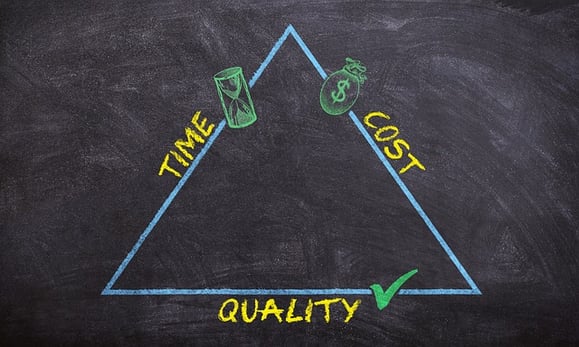
In the competitive landscape of B2B marketing, simply having a massive volume of leads is not enough to guarantee success. Businesses increasingly recognize that lead quality is a far superior indicator of the ultimate goal of converting sales; as the old saying goes, quality over quantity.
To achieve this, businesses must find ways to optimize resource allocation and ensure that they focus efforts on leads with the highest conversion potential.
In this article, we'll explore strategies, tools, and methodologies to optimize lead quality for sales conversion.
Understanding the Importance of B2B Lead Quality

As a business leader, marketer, or salesperson, you likely don't need to be reminded of the importance of lead quality. However, it's worth revisiting the immense impact it has on your bottom line to stay sufficiently motivated.
High-quality B2B leads, particularly, are strongly aligned with your company's offerings. At the same time, these leads should demonstrate a high level of engagement and relevance. Leads that meet these criteria are more likely to progress along the sales funnel.
In fact, according to SOMA metrics, high-quality leads can result in 10x more closings within a year. While low-quality leads may offer upfront savings, they can cost up to 5x more to convert over the entire sales lifecycle.
Overall, marketing automation is the major driver empowering companies to qualify and pursue high-quality leads. Statistics show that adopting it can lead to a 451% increase in qualified leads. Marketing automation can also contribute to an 80% surge in leads, while 77% of marketers who use it convert more leads than those who don't.
Strategies to Optimize Lead-Quality In-House

Strategy 1: Align Marketing and Sales on Lead Definitions
It's virtual that marketing and sales agree on what constitutes a "sales-qualified lead." This allows for more consistency across the entire sales funnel, from marketing to lead acquisition to sales.
Unfortunately, as few as 45% of companies share an organization-wide definition. This disconnect often results in missed opportunities and inefficient resource usage, hampering the sales process.
Organizations can define sales-qualified leads in the following way:
- Ensure marketing and sales teams fundamentally agree on what qualifies a lead.
- Identify buyer interest behaviors, such as engagement levels, website visits, content downloads, etc.
- Determine the essential demographic information that qualifies a lead, like industry, job title, and company size.
- Evaluate how leads interact with marketing materials, such as emails or events.
- Continuously review and refine these criteria based on sales feedback and market trends.
Strategy 2: Implement Effective Lead Scoring

Lead scoring involves systematically evaluating leads by assigning values based on their behavior and demographic information. It's the actual implementation of having agreed on a company-wide definition of a sales-ready lead.
By ranking leads based on their likelihood to convert, it helps prioritize efforts on the most promising prospects. An Eloqua study involving 10 B2B companies revealed that implementing lead scoring can result in a 30% increase in deal close rates and an 18% rise in company revenue.
You can segment lead indicators into explicit (job criteria, industry, etc.) and implicit criteria (engagement, site visits, etc.). Assign a score to each and weigh them according to their perceived value. Lastly, use automated tools to track and update these scores.
Strategy 3: Commit to Comprehensive Lead Nurturing
The act of building and sustaining customer relationships at each phase of the sales funnel is known as lead nurturing. It revolves around listening to prospects' needs and offering them the information and answers they need.
A report by Forrester Research shows that Businesses proficient in lead nurturing can produce 50% more sales-ready leads while incurring a 33% lower cost. Lead nurturing has the potential to maximize the lifetime (LTV) of B2B customers, particularly for companies that value long-term business relations.
A few practical steps businesses can use to step up lead nurturing are:
- Segment leads based on behavior and interests.
- Tailor content to meet the specific needs of each segment.
- Use email automation for timely follow-ups.
- Analyze interactions to refine your strategy continuously.
- Foster trust through educational content, not just sales pitches.
Strategy 4: Establish a Marketing-Sales Feedback Loop

Aside from establishing cross-discipline definitions of important sales concepts, effective collaboration between your marketing and sales teams is a must. This includes an effective marketing-sales feedback loop to ensure the continuous alignment of strategies.
Marketing teams can use this feedback to fine-tune campaigns based on direct sales feedback. And sales teams can ensure that marketing efforts go toward attracting leads that fit their target market.
To do this:
- Regularly share lead performance data between sales and marketing.
- Use feedback to adjust marketing campaigns and targeting criteria.
- Foster open communication channels for real-time feedback and adjustments.
Strategy 5: Leverage Marketing Automation Software
Marketing automation tools like HubSpot, Marketo, and Salesforce Pardot can greatly enhance lead quality management. This is especially true for companies that operate at scales where traditional methods become difficult to manage.
9 out of 10 marketers say that automation is helping them achieve their objectives. With such a clear value proposition, it's no surprise that demand is on the rise. Soon, adopting marketing automation will not simply be a matter of optimizing the sales process but a necessity to keep up with the competition.
Integrating these tools with CRM systems helps improve the understanding of lead behavior and campaign performance. This allows for forming a holistic view of the customer journey.
Conclusion
Taking charge of our own destiny by embracing an in-house approach to lead quality improvement should be something that everyone in the B2B space strives for. Businesses successfully implementing these strategies see remarkable improvements in outcomes, such as a 30% increase in close rates.
A shift toward quality-centric lead generation streamlines sales processes, boost revenue, and enables business growth in the long term. Luckily, the plethora of marketing automation tools means that this ideal is within reach for B2B businesses of all sizes. To stay competitive and maximize your sales opportunities, there's no time like the present to start.